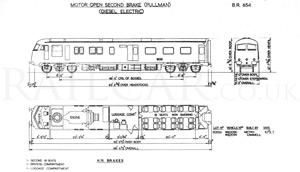Blue Pullman
Type 2 - Motor Car (WR)
DMBS (Driving Motor Brake Second)
W60094-9
18 2nd class seats
67 1/2 tons
Lot no. 30554
Diagram BR654
The biggest difference between the two power cars was the passenger saloons being second class rather than first. There was no toilet/luggage rack in this vehicle, being replaced by an extra seating bay on either side, and these could be identified externally by the larger window for this. Other external clues when new were that there was just the raised lettering "Pullman" at the top of the bodysides (no "Midland"), and in the centre of the vehicle was an extra 'window' which was actually a destination indicator. Whereas the LMR sets only worked one service, the WR needed to avoid people getting on the wrong train.
The indicators were provided on both sides of each motor car showing the train name and destination station together with intermediate calling points. These were displayed on roller blinds through a glazed panel which could be illuminated when required. The light switch was on the partition wall to the right of the guards table. The correct method display was for the roller blinds to be adjusted so that, except where 'Special' was exhibited, the train name appeared at the top of the panel with the destinations beneath it.
The indications on the roller blind could only be altered from inside the train. To do this the indicator box was opened by releasing the clips, the blind could then be moved by operating the handle. One indicator was accessible from the guard's compartment, the other from the generator compartment immediately opposite the communication door leading from the guard's compartment.
In common with the LMR, for maintenance purposes each WR train was made up of two half-sets. These half sets were allocated the numbers 4 to 9 inclusive. The numbers were carried on the solebar of the motor car second in each half set in the form of a small metal plate with white lettering on a blue background. The number allocated corresponded with the last digit of the individual number of each vehicle forming the half-set. (i.e. 60094 was half set no. 4).
Summary
Development
Press run 24/6/60
Press run 7/9/60
Staff difficulties
Ownership agreement
Manufacturer's Publicity
Description
Type 1 - LMR motor car
Type 2 - WR motor car
Type 3 - WR parlour 2nd car
Type 4 - LMR kitchen car
Type 5 - WR kitchen car
Type 6 - LMR/WR parlour 1st car
Interior
Air conditioning
Motor cars
Auxiliary power
Bogies & couplings
Brakes
Data
Sub contractors
Staff instructions
LMR services begin
LMR Publicity
LMR brochure
LMR handbills
Controversy
WR services begin
WR publicity
WR publicity brochure
WR publicity leaflet
LMR Operations
WR Operations
Liveries
Rundown & withdrawal
After service & preservation
Disposal
Maintenance Manuals
Miscellaneous
Acknowledgments & Further Reading
Images
No vehicles were preserved.



